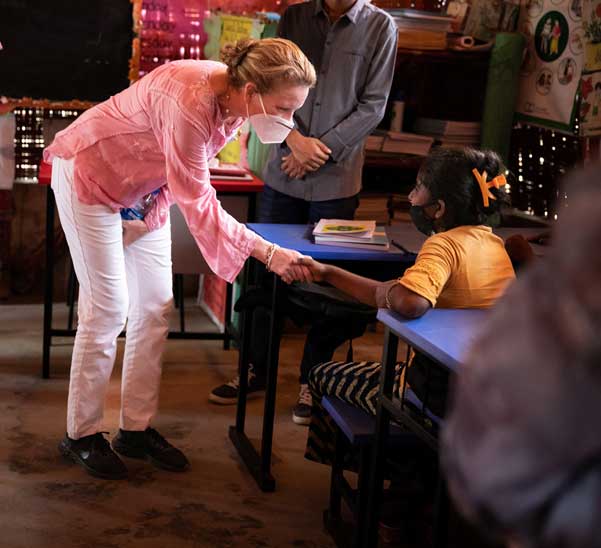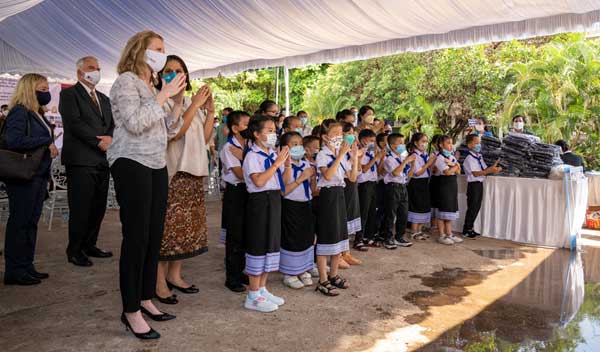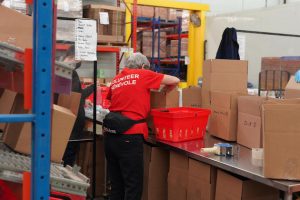
By External Source
Jul 12 2022 (IPS-Partners)
Isobel Coleman was sworn in as Deputy Administrator for Policy and Programming at the United States Agency for International Development (USAID) in November 2021.
As USAID’s Deputy Administrator, Isobel Coleman is responsible for program and policy oversight. She guides USAID’s crisis response, and she is also responsible for overseeing Agency efforts to prevent famine and future pandemics, strengthen education, health, democracy and economic growth, and improve responses to climate change.
Ambassador Coleman is a foreign policy and global development expert with more than 25 years of experience working in government, the private sector and non-profits.
ECW: When it comes to education aid funding, why is it important to prioritize the most vulnerable girls and boys – those whose lives are impacted by armed conflicts, forced displacement, climate-induced disasters – through organizations like Education Cannot Wait?
Isobel Coleman: At USAID, we know that to achieve Sustainable Development Goal (SDG) 4 – equitable, inclusive quality education for all – we must prioritize the unique needs of the most vulnerable children and youth. Half of USAID’s basic and higher education funding is spent in regions experiencing conflict and crisis. But we are well aware that the scale of global need is growing due to crises such as the COVID-19 pandemic, rising political instability and climate-induced disasters.
Education Cannot Wait (ECW) plays a vital role in addressing the educational needs of children and youth in acute and forgotten crises. As the only global fund dedicated to education in emergencies, ECW is uniquely positioned to coordinate among donors, the private sector, and humanitarian and development actors to meet the needs of the next generation. The work of ECW is helping ensure this growing population has the skills and abilities to sustain themselves while engaging as productive citizens in their communities.

ECW: Newsweek has named you one of the “150 Women Who Shake the World” and, in your current role at USAID, you are an inspiration to young and adolescent girls. With so many girls being left behind without access to education, why must – and how can we – best empower an entire generation of girls and young women to become the leaders of tomorrow?
Isobel Coleman: Research shows that education is certainly among the most powerful drivers of women and girls empowerment, and critical to achieving development and humanitarian outcomes. According to UNESCO, 15 million girls and 10 million boys worldwide will never set foot in a classroom; refugee girls are half as likely as their male counterparts to be in secondary school.
In Afghanistan, the Taliban’s decision this Spring not to reopen schools for girls above Grade 6 is a terrible blow to the gains in education that girls have been steadily making in that country. It is simply unacceptable that some three million school-aged Afghan girls are out of school due to economic, political and cultural barriers. USAID works to break down gender-related barriers to education so that all learners ¬– especially girls and women – have access to quality learning opportunities from pre-primary through higher education.
Educating girls and young women is an investment not only in them as individuals, but also in their future families, their communities and society at large. The evidence is clear – when a female head of household has an education, particularly a secondary school education, they can more sustainably escape a lifetime of poverty for themselves and their family, even in the face of conflict, crisis or other adversities.
In fiscal year 2020, the U.S. government provided more than 24 million primary and secondary students in 53 countries with opportunities to learn literacy, numeracy and other basic skills; distributed more than 31 million textbooks and other teaching and learning materials; and provided education to approximately 12 million women and girls. In Afghanistan, we are working hard to find ways to sustain access to education at all levels through support to Afghan-owned and operated community-based and private education.
At USAID, empowering women and girls through education is part of a broader approach to inclusion for all marginalized populations. We are working to better understand the root causes of marginalization and focusing our interventions on serving the most marginalized learners, including adolescent girls and those facing intersectional challenges such as disability, displacement and extreme poverty.
I want to emphasize the importance of supporting women to advance and succeed in leadership positions within education systems. Adolescent girls need role models and leaders in both the school and classroom, their communities and in public offices who will advocate for their specific needs with high levels of influence. When women are equitably represented in education leadership – whether at the international, national or even individual school-level – all learners, especially adolescent girls, benefit exponentially.
ECW: In your capacity as USAID Deputy Administrator for Policy and Programming, how do you see the role of multilateralism to steer the advancement of the Sustainable Development Goals (in particular, SDG4, equitable, inclusive quality education for all) – particularly given ECW’s new data which shows there are now 222 million crisis-affected children and adolescents who need urgent education support?
Isobel Coleman: The United States has long championed international basic education. We are the largest bilateral funder of international basic education because we understand education is a foundational driver of development and is transformational for individuals and societies.
The U.S. will continue leading in international education through our bilateral and multilateral assistance. Working with all stakeholders, including our multilateral partners, builds resilient education systems, improves learning outcomes, and reaches the most marginalized children and youth. Through our support to multilateral partners, such as Education Cannot Wait, working in concert with our bilateral programs in basic and higher education, we maximize our ability to reach the greatest number of children and youth, and help deliver on SDG4.
A great example of our multilateral and bilateral assistance working together is in northern Mali. Last October, USAID contributed an additional $5 million to ECW’s programs in Gao, Kidal and Timbuktu to ensure continuity of learning opportunities, while USAID programming helped build resilient education systems for conflict-affected communities.

ECW: Why is investing in education in crisis-contexts like the Sahel, Yemen and beyond important for global social and economic security, and why is this important for the American people? Why should the private sector – including leading American companies – invest today in education in emergencies and protracted crises?
Isobel Coleman: Inclusive, quality education can reduce conflict and promote political and economic stability. But who delivers it – and what is taught – is crucial to promote democracy and prevent influence from malign actors. The private sector benefits from increased global stability, so it has not only a social responsibility, but some self-interest in joining international donors to address the educational needs of children and youth and help set them up for lifelong success.
Given the funding gap in education, we need EVERYONE to respond – donors, governments and the private sector. This is not an issue that any one entity can solve alone. The pandemic-related challenges that teachers and students continue to face globally have only expanded existing gaps and highlighted the need for new and non-traditional funding.
ECW: The climate crisis is an education crisis. How can we better connect education – especially for crisis-affected girls and boys – with climate action?
Isobel Coleman: Climate change poses challenges to education infrastructure and learning outcomes. It impacts marginalized populations disproportionately, worsening poverty and exacerbating non-climate stressors. However, strong education systems with emergency response capacity and plans can implement proactive measures to minimize damage and disruption due to climate events, such as droughts and hurricanes. Often after a natural disaster, the opening of schools signals the return to normalcy for both families and businesses, enabling early recovery. Therefore, investing in education during acute crises is also essential for children and the wider community.
Responding to the climate crisis is a USAID priority. USAID recently launched an ambitious 2022-2030 Climate Strategy to better support countries to adapt to climate change, leverage resources to mobilize both public and private climate finance, increase technical assistance to those most at risk of climate impacts, and cut the Agency’s carbon footprint. We are currently developing guidance to articulate how USAID’s programs can advance climate mitigation and adaptation across all levels of education, including by:
- • Partnering with Ministries to integrate climate themes in curriculum and trainings
• Supporting education leaders to plan for climate resilience and green infrastructure
• Supporting youth to build skills for green jobs and engaging youth leaders to advocate for improved environmental practices and attitudes in their communities
• Leveraging the capacity of higher education systems to serve as climate action leaders and knowledge generators
• Improving risk management and capacity through training.

ECW: Our readers would like to know a little about you on a personal level and we know that reading is crucial to every child’s (and adult’s) growth and development. What are some of the books that have most influenced you and why would you recommend them to others?
Isobel Coleman: Reading absolutely is critical to personal growth and development! I was, and still am, an avid reader. I devour biographies, read mostly non-fiction, but also love fiction too. So many books have left indelible impressions on me – it’s a struggle to pick a few. But one that stands out is Strength in What Remains, a book by Tracy Kidder about the remarkable Deo who survived genocide and civil war in Burundi, made his way to America and through tremendous hard work, tenacity, perseverance and the kindness of strangers, became a doctor working with Partners in Health. It’s a truly inspirational journey. I’ve had the honor of getting to know Deo over the years and watched with awe and admiration as he’s devoted his life to helping others.
USAID recognizes the vital importance of ensuring that all children and youth have access to quality books in languages they understand to achieve literacy. Along with other donors and partners through the Global Book Alliance, USAID is proud to support the Global Digital Library, an open-source library maintained by the Norwegian Agency for Development Cooperation that makes 6,000+ high-quality reading resources available in 83 languages, including under-published languages. The library breaks down physical barriers to accessing books and is accessible to those with disabilities.
